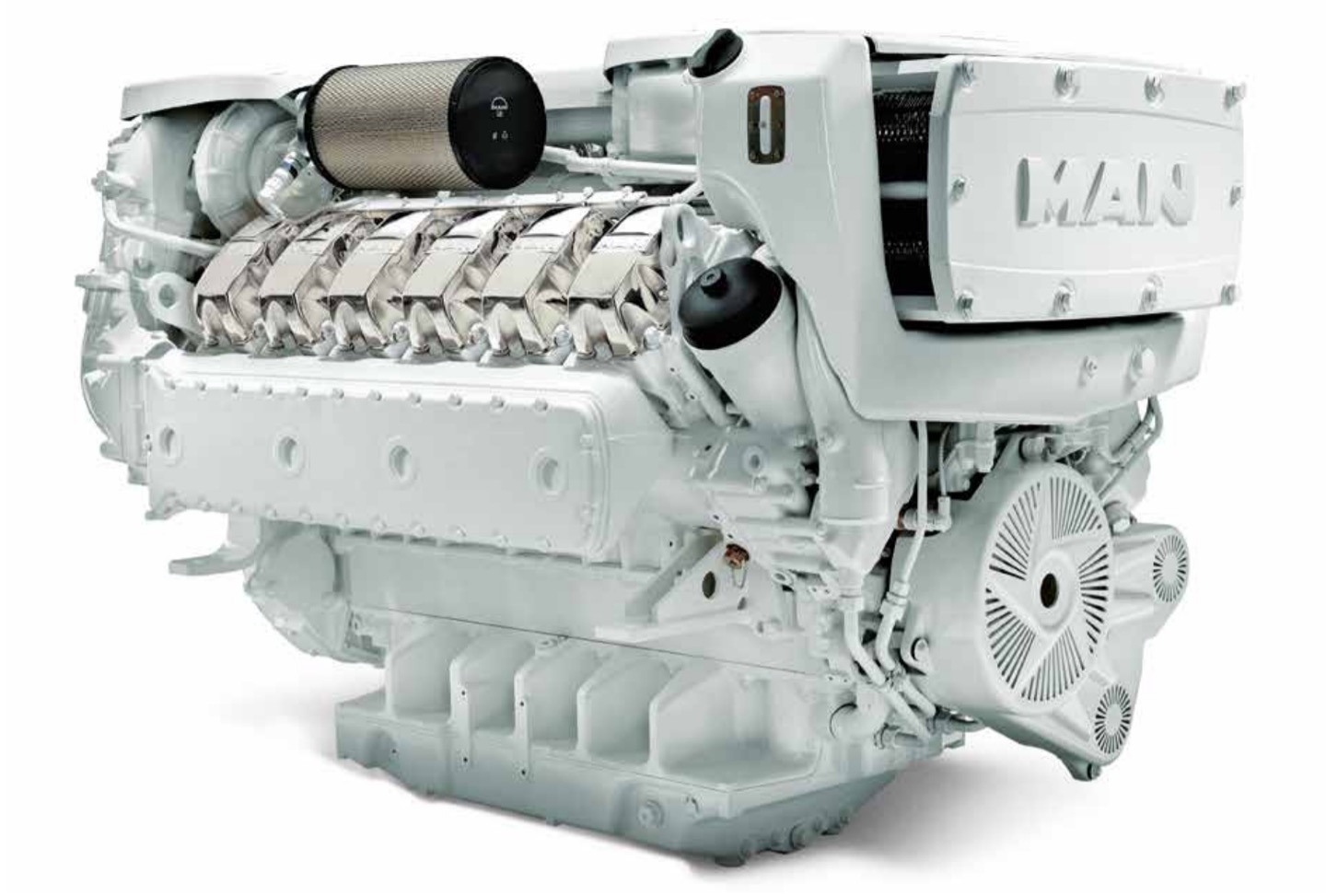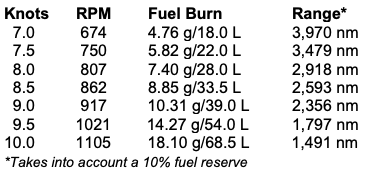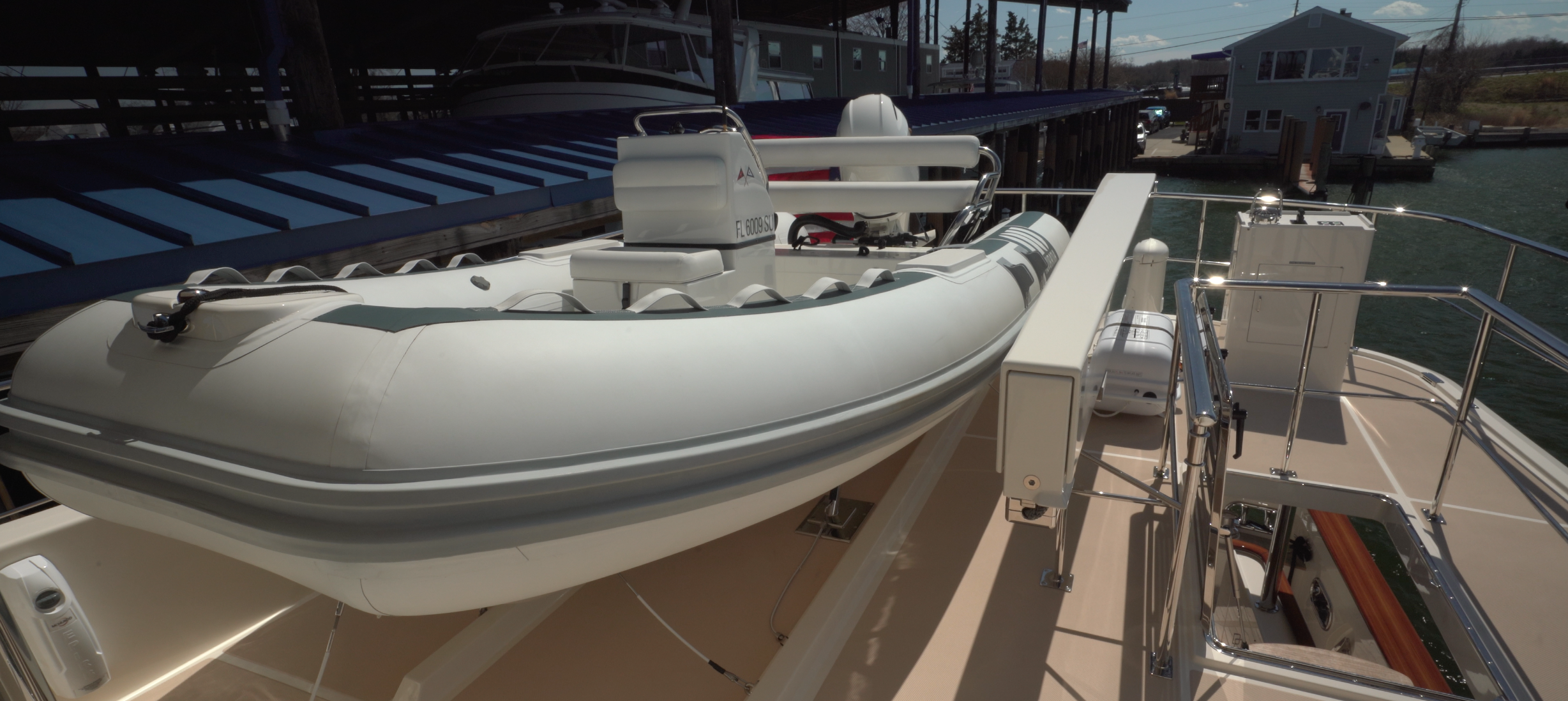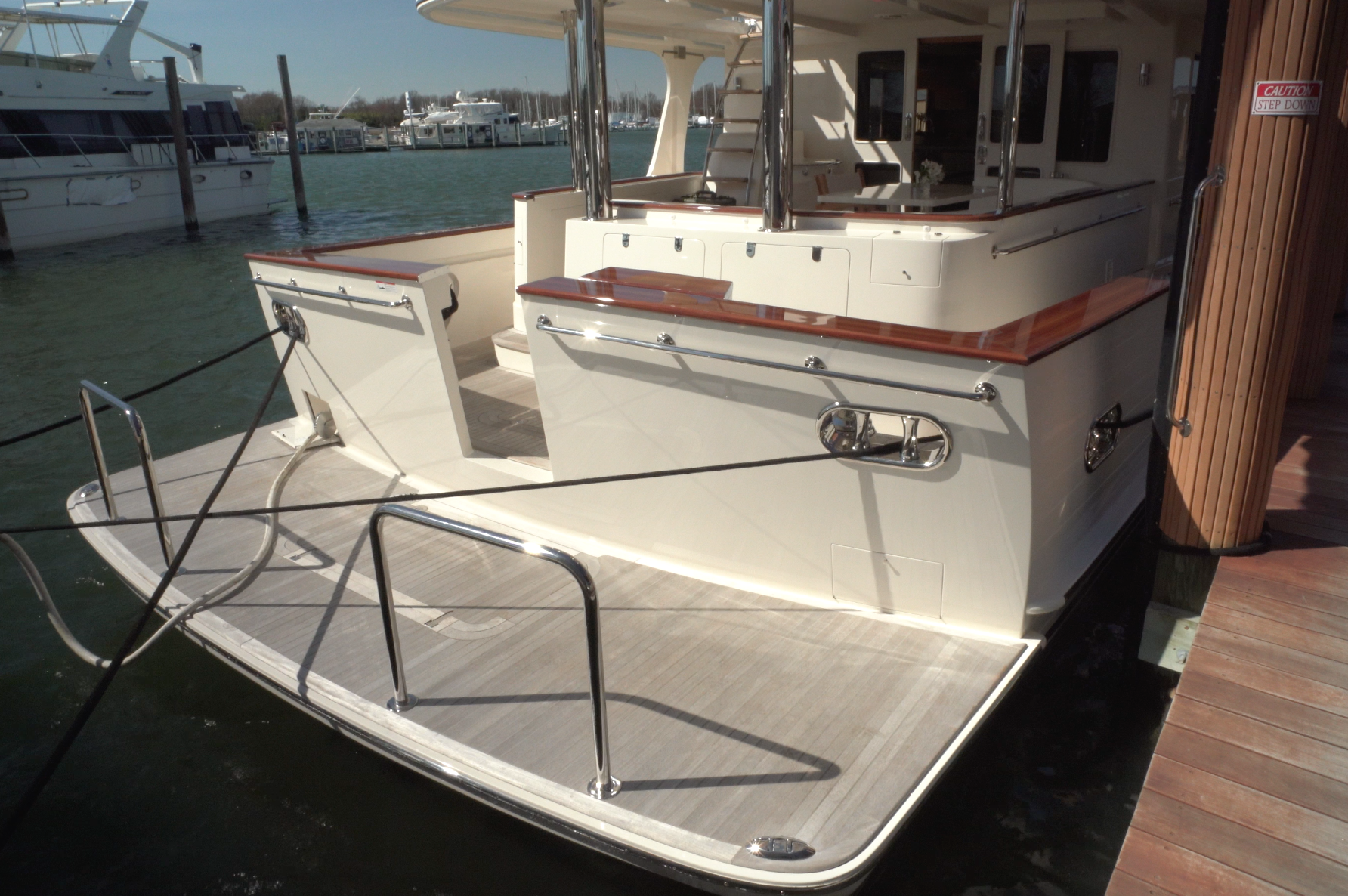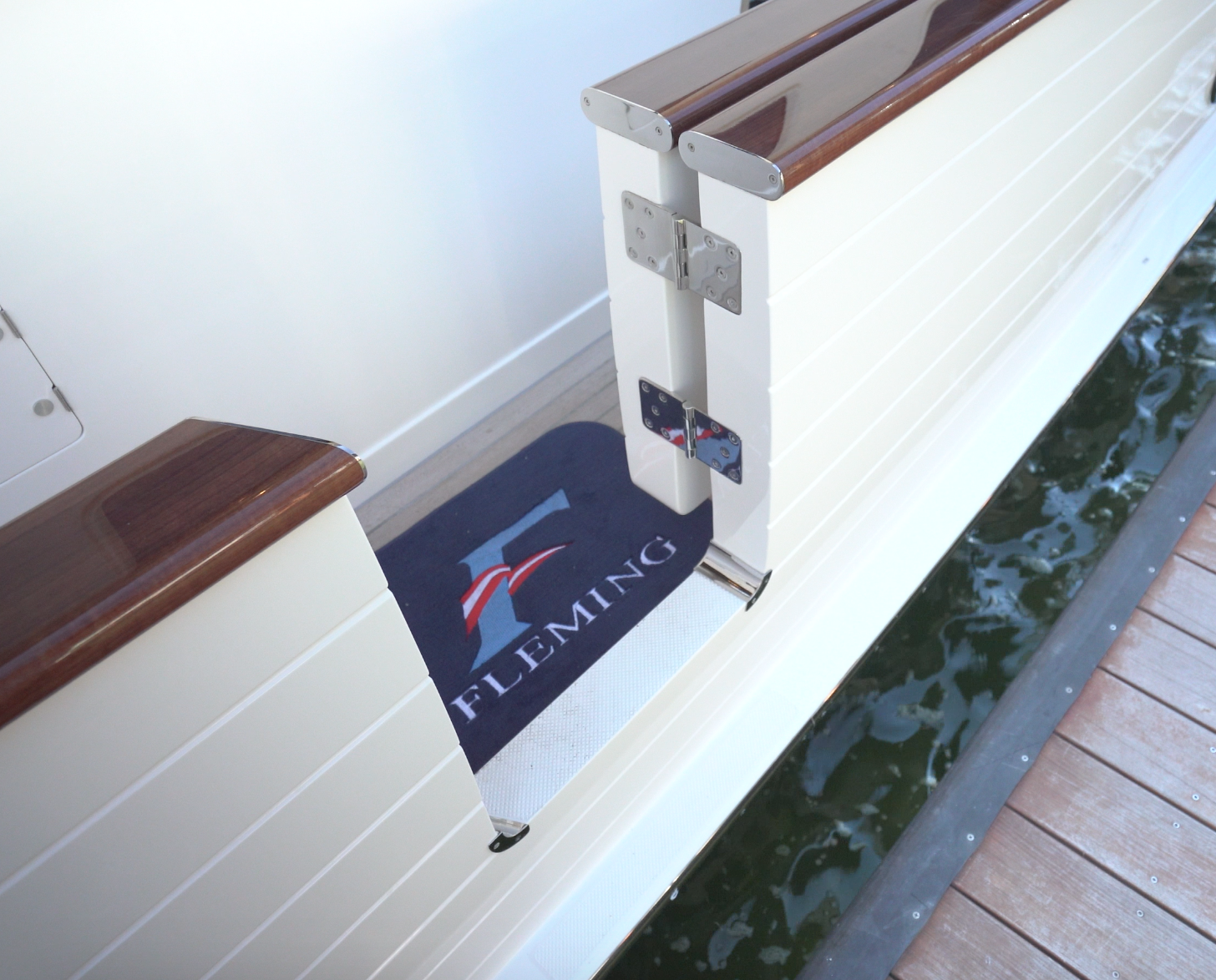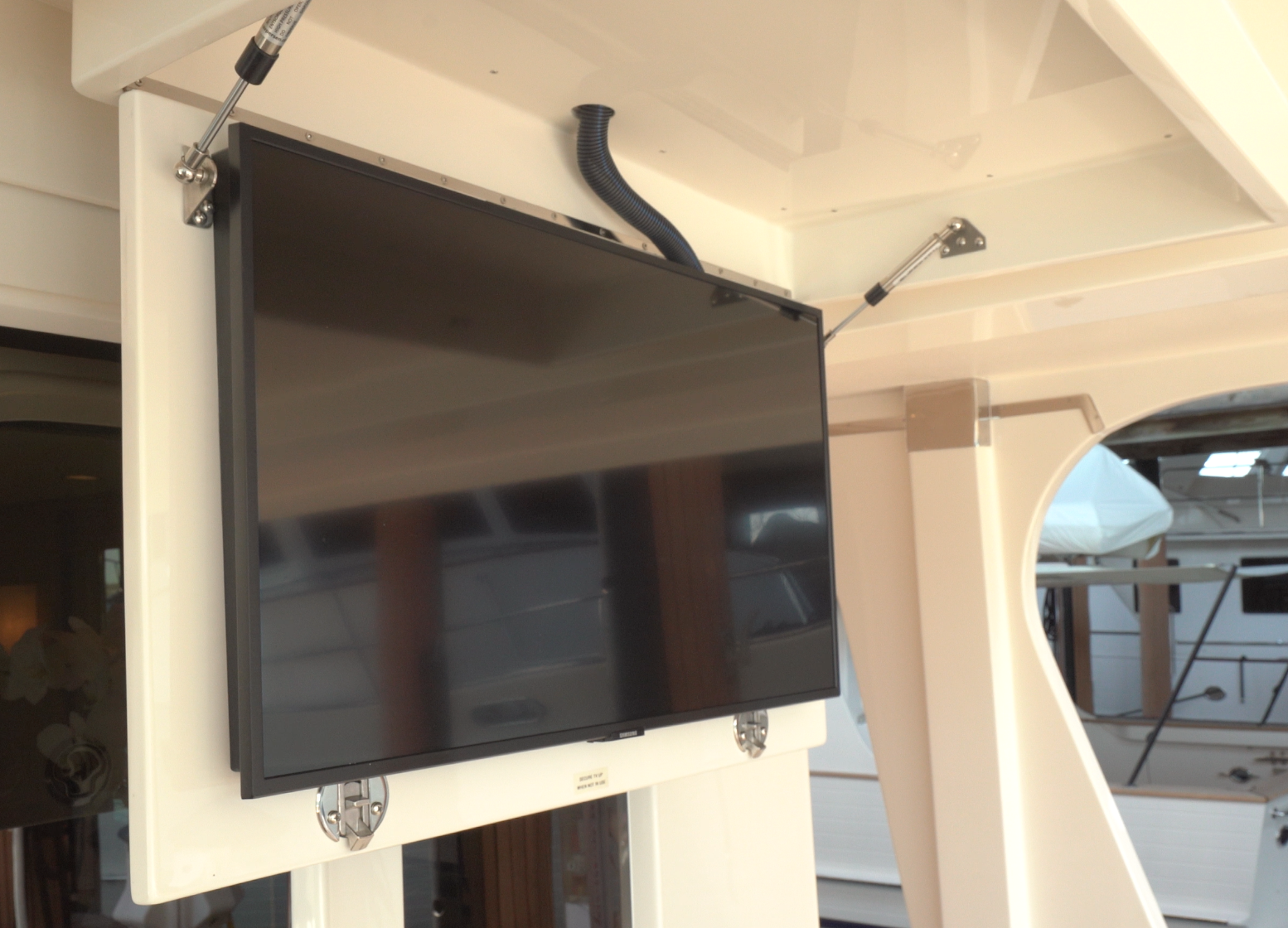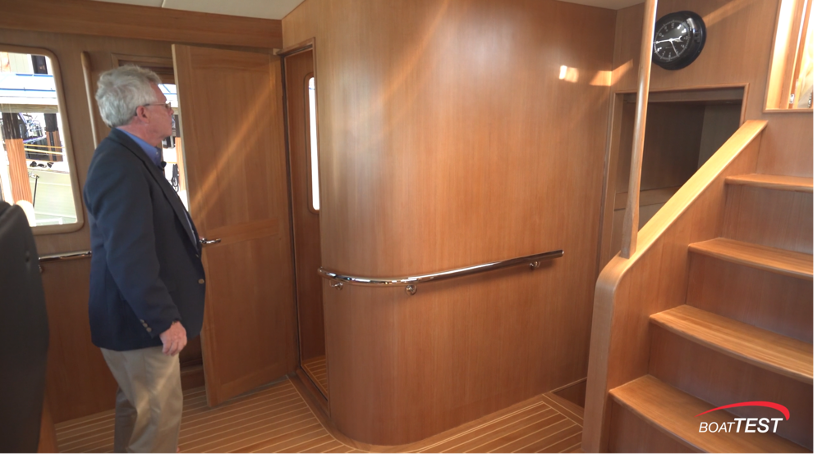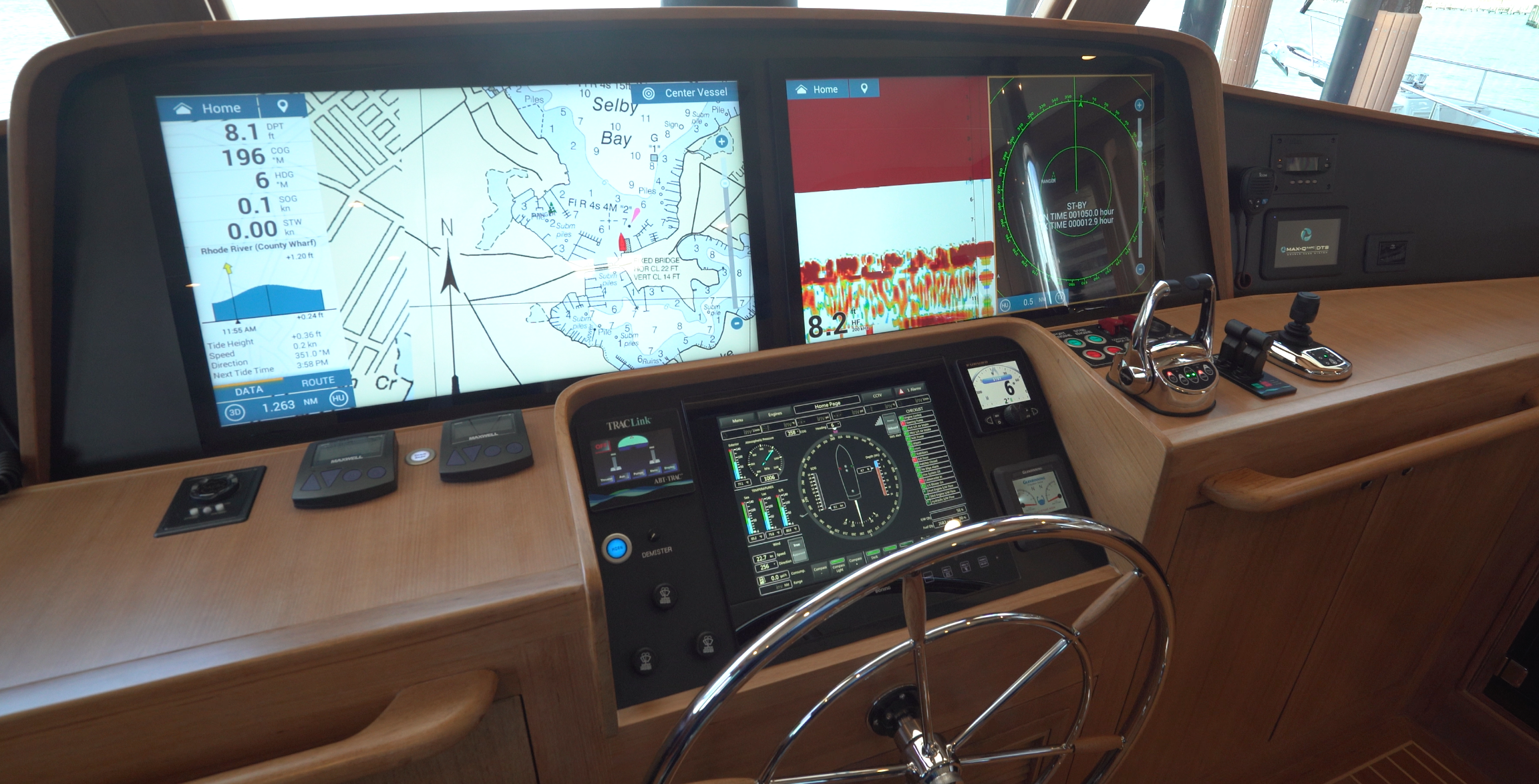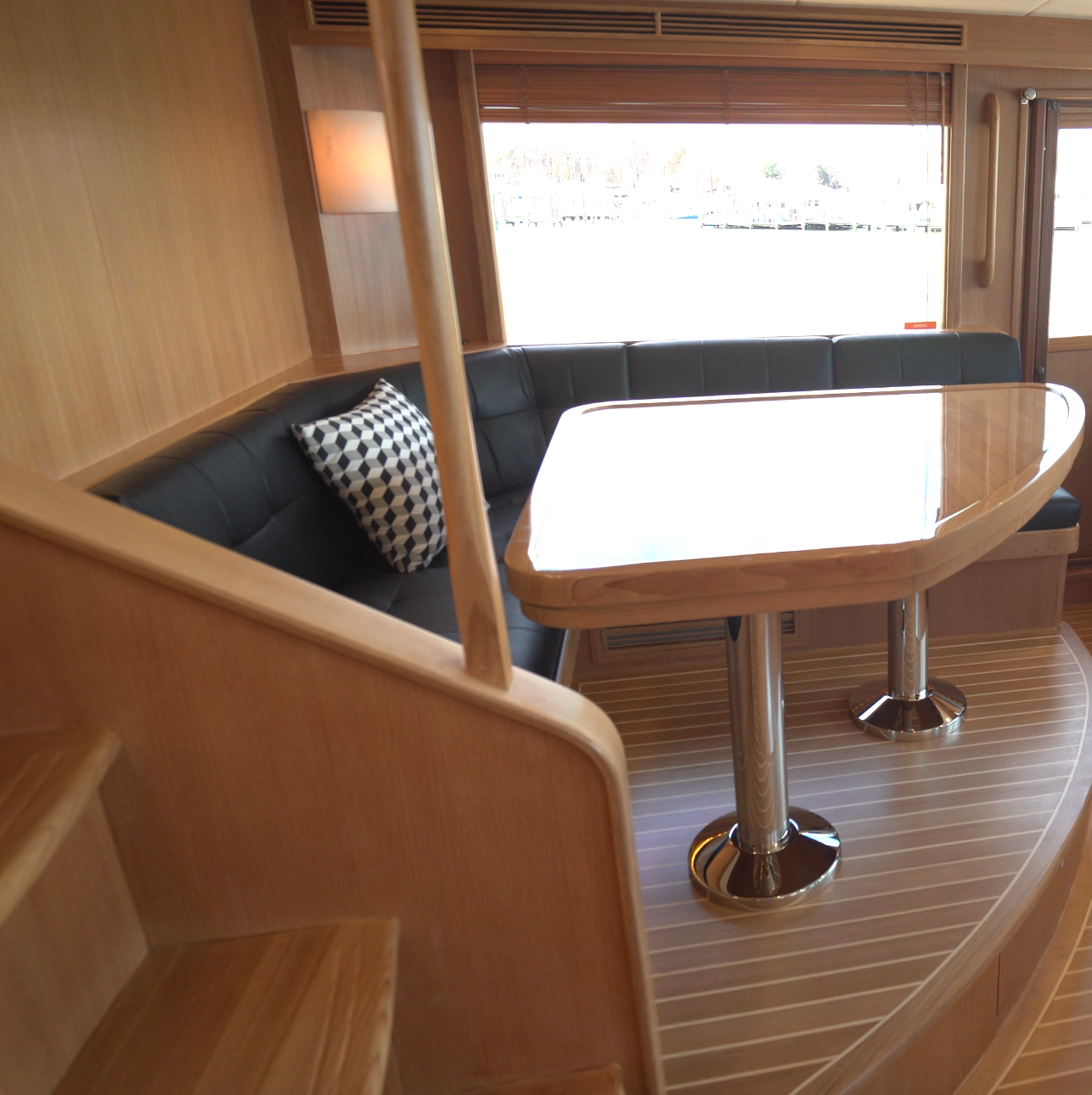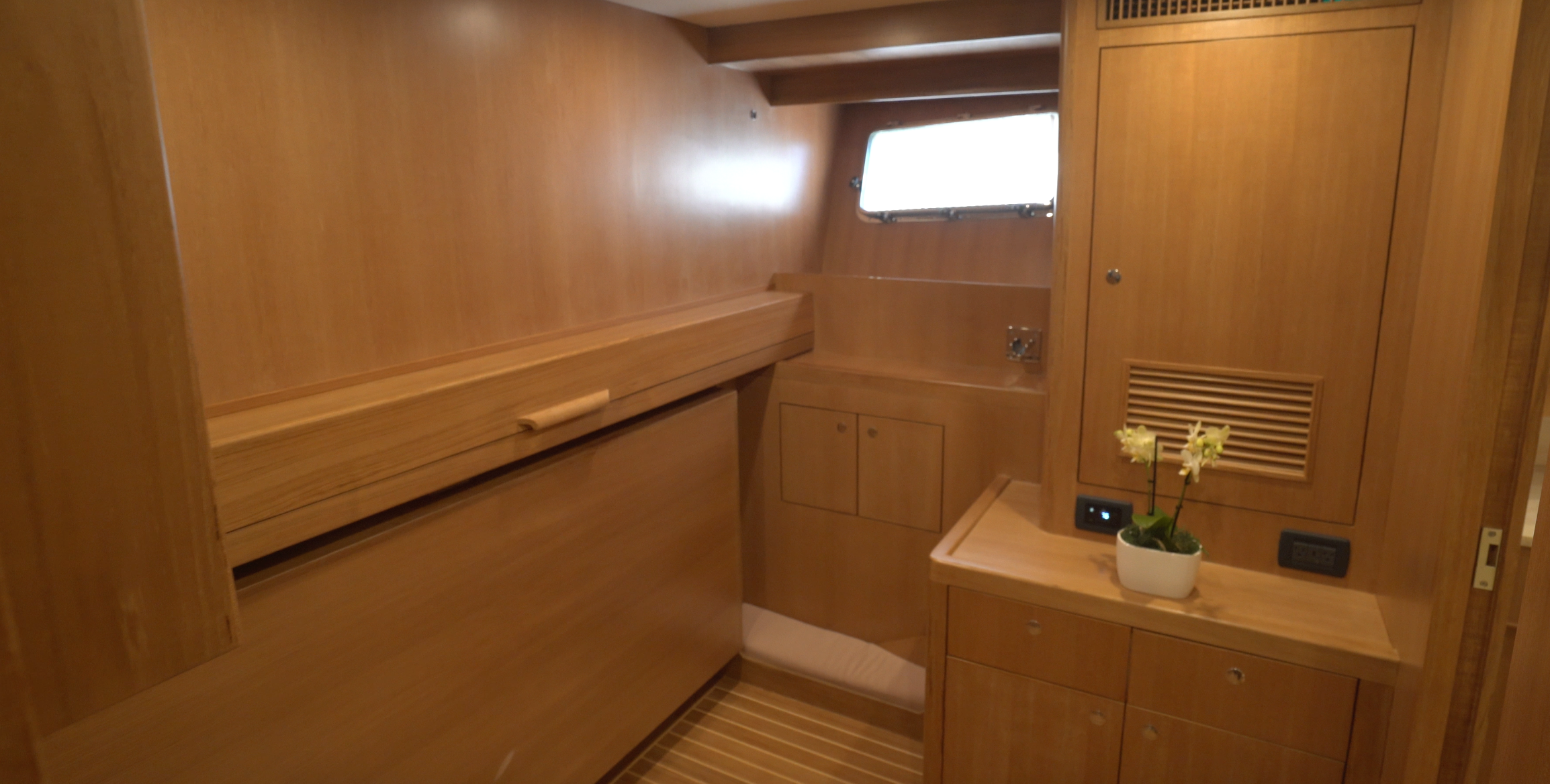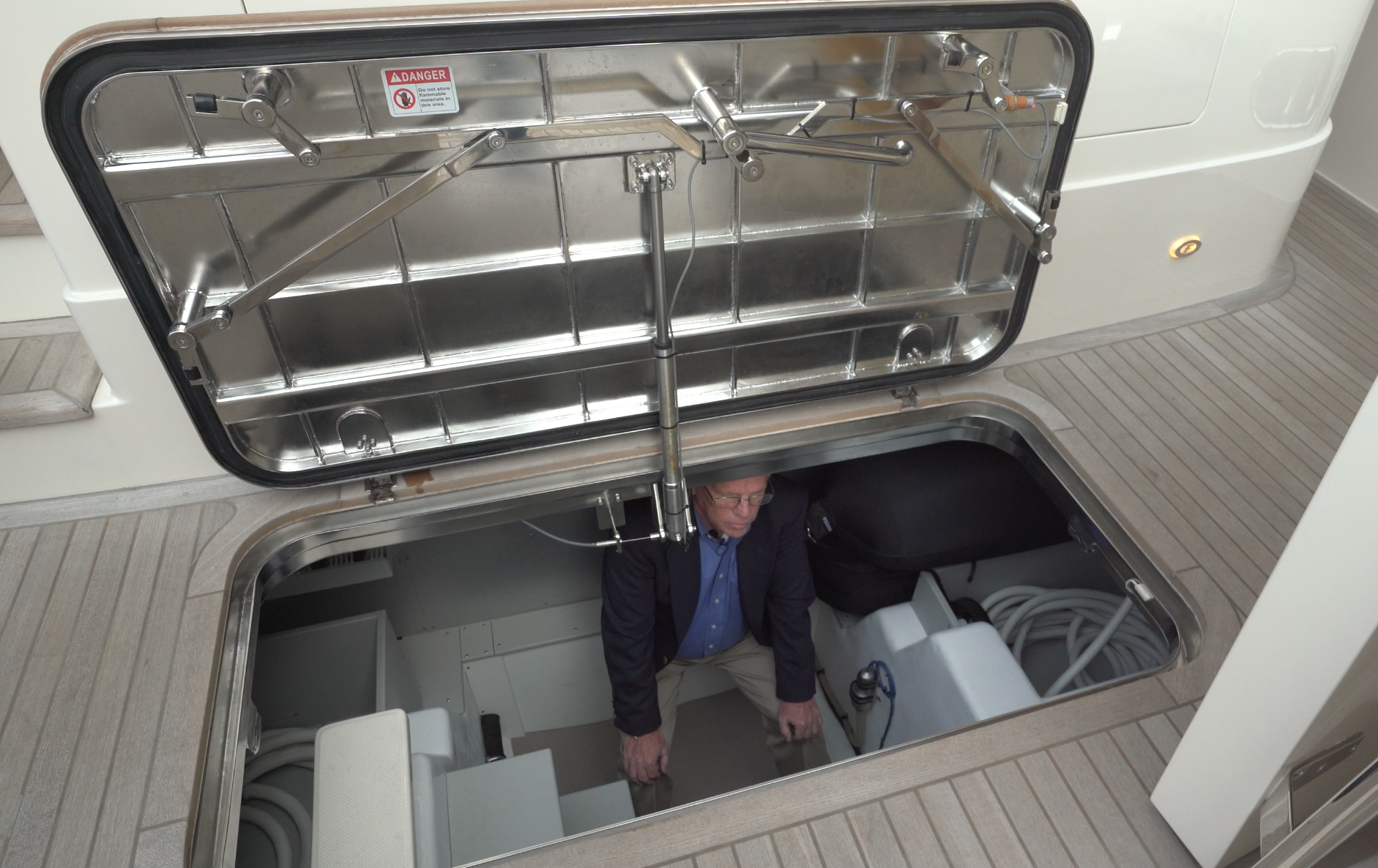Access More Boat Tests
Already have an account? Login
Fleming Yachts 78 (2021-)
2 x 1,550-hp MAN V12
Brief Summary
The Fleming Yachts 78 is a long-range cruising yacht targeted at experienced owner-operators. Because her stem to transom measurement is under 80’ (24.38 m), most insurance companies will allow the owner to command this vessel, given appropriate experience.
Test Results
| RPM | MPH | Knots | GPH | MPG | NMPG | STAT. MILE | NM | dBa |
|---|---|---|---|---|---|---|---|---|
| 650 | 7.9 | 6.8 | 4.5 | 1.7 | 1.5 | 4710 | 4095.7 | N/A |
| 1000 | 10 | 8.7 | 13 | 0.8 | 0.7 | 2075 | 1803.9 | N/A |
| 1250 | 12.7 | 11 | 27 | 0.5 | 0.4 | 1267 | 1102 | N/A |
| 1500 | 14.8 | 12.8 | 42 | 0.4 | 0.3 | 948 | 824.5 | N/A |
| 1750 | 16.4 | 14.2 | 74.4 | 0.2 | 0.2 | 594 | 516.3 | N/A |
| 2000 | 19.4 | 16.9 | 112.8 | 0.2 | 0.1 | 464 | 403.8 | N/A |
| 2100 | 20.9 | 18.1 | 125.8 | 0.2 | 0.1 | 448 | 389.3 | N/A |
| 2200 | 22.8 | 19.8 | 140.9 | 0.2 | 0.1 | 437 | 379.9 | N/A |
| 2300 | 24.5 | 21.3 | 161 | 0.2 | 0.1 | 411 | 357.3 | N/A |

Specifications
| Length Overall |
81'6" 24.84 m |
|---|---|
| Beam |
21'5" 6.53 m |
| Dry Weight |
165,048 lbs. 74,864.5 kg |
| Tested Weight |
187,150 lbs. 83,857.43 kg |
| Draft |
5' 1.52 m |
| Bridge Clearance |
21'8" 6.6 m |
| Fuel Capacity |
3,000 gallons 11,356.24 L |
| Water Capacity |
440 gallons 1,665.58 L |
| Total Weight |
187,150 lbs. 83,857.43 kg |
Acceleration Times & Conditions
| Props | 41" x 39.5" |
|---|---|
| Load | 2 persons; 75% fuel; 75% water; 50 lbs. gear |
| Climate | 78 deg.; 68 humid., winds: 12-15; seas: 1 |
Engine Options
| Tested Engine |
2 x 1,550-hp MAN V12 |
|---|---|
| Std. Power |
2 x 1,550-hp MAN V12 |
Mission Statement
As we’ve found with all Fleming Yachts, the 78 has a primary mission of accommodating an owner-operator and family members during an extended stay at sea, in comfort and safety.
She is intended to be able to handle trans-oceanic distances at displacement speeds, however, with twin 1,550-hp MAN V12s, she can exceed 20 knots if desired with a 75% fuel load. With 3,000 gallons (11,356 L) of fuel, she is a trans-oceanic vessel at displacement speeds.
Distinguishing Features
-
Centralized Hydraulic System. It drives the bow and stern thrusters, stabilizers and twin Maxwell windlasses in the bow.
-
Segregated Keel. As with all Flemings, the 78’s full-length keel is filled with a closed-cell foam core material and it’s sealed off from the hull to protect against water intrusion. It’s also protected by a full-length stainless steel shoe.
-
Fuel Tanks Built In-House. Fleming manufactures its own pressure-tested fuel tanks out of vinylester and fire-retardant resins. The tanks are glassed to the hull structure and it spans the hull’s full beam.
-
Central Monitoring System. Boning/Fleming system has 15” (38.1 cm) color touchscreens at the upper and lower helms and in crew quarters that monitor virtually every onboard function.
-
Wide Side Decks. A Fleming trademark, they make it easy to move forward and aft in less-than-ideal conditions.
-
Tender Storage. The aft section of the flybridge has space for a tender up to 17’ (5.18 m) long and a 12-foot (3.66 m), 1,500-lb. (680.39 kg) capacity hydraulic davit comes standard.
-
5 Control Stations. In addition to the upper and lower helms, there is a control station aft on the boat deck and one on each side of the boat.
Performance Numbers
Performance is one of the most important aspects of the Fleming 78 because she is intended to cross oceans. That means the 78 has to have a comfortable range of at least 2,200 nautical miles (the distance from L.A. to Hawaii).
Several gears have to mesh perfectly to get that range. It starts with the engines. The first decision to make is whether to go with smaller engines with less horsepower and remain at displacement speeds with WOT in the low teens and high fuel consumption or to go with higher horsepower that can push the boat past 20 knots at WOT.
Fleming’s answer is to go with the latter option because not only can the 78 go over 20 knots but she will also burn less fuel at displacement speeds than she would with smaller engines. It sounds counter-intuitive but it is a fact that has been borne out in tests conducted by BoatTEST. The next question is which brand and engine model to select?
Fleming offers only 1,550-hp MAN V12 diesels in its 78. The basic reason is simple. At 5,004 lbs. (1,270 kg), she is 35% lighter than her conventional alternative brand and model, while generating the same horsepower of 1,550-hp at 2300 rpm. The second reason is more subjective: reliability and access to service and parts. We are told by virtually all of the boatbuilders we have queried on this matter that MAN has vastly improved on these important details over the last 20 years.
The third reason is that the 1,550-hp MAN V12 is more compact – its envelope is 8” (20 cm) shorter and has 13” (33 cm) less width than the traditional engine in this horsepower. That adds up to saving 26” (66 cm) of beam space in an engine room crammed with gear, which is an important consideration.
BoatTEST conducted a series of tests on the Fleming 78. On test day, the air temperature was 78-degrees F with 53% humidity. Wave height was about 1' (0.3 m) and the wind was 12-15 knots, which is not enough for white caps, other than a few here and there. We ran reciprocal courses four times over a two-and-a-half-hour period. Happily, we were testing at nearly slack tide, which made our task less challenging than normal.
The weight of the boat is critically important when testing and virtually all third-party testing is done with the fuel that the boat has when delivered. That is why consumers need to look at that number or percent in the fine print. In the case of our test on the 78, her fuel tanks were 75% full and the water tanks totaled 30% full. This created a boat of nearly 188,000 lbs. (85,454 kg)
WOT Speed. Everyone wants to know what the top speed of a boat is even though that speed is rarely driven. It is the same with the horsepower. All engines are rated at nearly peak rpm. Since the boat is almost never driven there, much less horsepower is actually harnessed and that is why the torque curve is important. The 24.24 L 1,550-hp MAN V12s develop max torque at about 1200 rpm and maintain it almost all the way to the top end. Our average top speed was 21.3 knots, where we burned 161 gph. See our standard chart for speed and fuel consumption at the basic rpm numbers.
Best cruise speed is hard to determine in a vessel such as this because, unlike a true planing boat, it can’t get up and ride on its bow wave. So, best cruise is determined by each owner based on how much fuel is burned for the speed produced. For those in a hurry to get to a harbor before nightfall or to cover a lot of distance during a three-day weekend, speed is important and that’s why Fleming has provided the engines it has. Most owners we know will operate the boat at about 1250 rpm. In this case, the boat averages 11 knots at that speed.
Ocean Cruising Speeds and Range
The normal BoatTEST performance table was designed for planing boats that account for the vast majority of boats we test. Long-range displacement cruisers, however, must be much more precise because just a small gph disparity can mean the difference between reaching a destination or not. It also makes a big difference for mariners operating on a budget.
For that reason, when testing the Fleming 78, we also recorded vital performance numbers in increments of .5 knots in the critical displacement speeds. Those results are —
Features Inspection
The Flying Bridge. All genuine cruising boats should have a boat deck and the Fleming 78 has one that can hold a 17’ (5.18 m) tender. Our test boat had its 1,500-lb. (680.39 kg) capacity hydraulic Steelhead davit placed nearly in the center of the deck so that the 1,050-lb. (476.27 kg), 15’6” (4.72 m) RIB Novurania tender with a 60-hp engine could be launched to either side or over the stern of the boat.
The stairs to the bridge are to port. Just ahead of the stairs is a bar with an electric grill, counter space for food prep and serving plus a sink forward. There are also two refrigerators. Opposite to starboard, a horseshoe-shaped lounge wraps around a stone surface table on dual stanchions. A fiberglass hardtop that’s 6’9” (2.06 m) off the deck provides shade and protection from a shower
Forward, the upper helm is offset to port with two 24” (60.96 cm) Furuno touchscreens flanking a 12” (30.48 cm) Bonin display in the upper section. A compass is in line with the steering wheel. On the lower panel, working left to right are the engine controls, thruster toggles, the joystick, stabilizer controls, the autopilot, spotlight and VHF radio. The engine start-stops are on a vertical panel.
The Stidd seat at the upper helm is doublewide and there’s a second Stidd seat to starboard along with another set of engine controls.
The Stern
Guests can step aboard the Fleming 78 from the full-beam swim platform that has enough fore-and-aft depth for greeting guests arriving by tender or supporting a tender. There are fold-up cleats in each aft corner and twin staple-style rails can be removed. The shorepower cord is in its own compartment to port and a centrally-mounted door in the transom swings inboard to access the aft deck.
The aft deck has two 14” (35.56 cm) cleats with hawse holes in the stern quarters with warping winches forward. All the pull handles for the fire suppression system are in a locker to port and a control station that has the engine levers and thruster toggles is to starboard.
The Side Decks
Working our way forward, a crew member can walk from the stern to the bow on 19”-wide (48.26 cm) side decks that are protected by 36” (91.44 cm) tall bulwarks. The synthetic “Burwood” caprails are 10 ½” (26.67 cm) wide and are notable because they can’t be distinguished from real teak yet they require almost no maintenance. Fleming customers can have the teak option but virtually all choose the “Burwood.”
Boarding gates port and starboard are 17” (43.18 cm) wide. There are four steps up to the Portuguese bridge that has two gates leading to the bow area. We’ve seen Fleming offer a variety of lounge configurations on the raised trunk cabin. Step down to the foredeck where there are cleats and two hawse holes.
Twin Maxwell windlasses are on a platform 15” (38.1 cm) off the deck with pulpit-mounted 132.28-lb. (60-kg) and 176.37-lb. (80-kg) ULTRA anchors. A hatch to starboard houses the windlass remotes and a 50-amp Smartplug outlet for shorepower plus storage. The port-side hatch has fresh- and raw-water washdowns while access to the separate rode lockers is aft.
Main Deck
The California Deck. It’s a step up from the aft deck to the California Deck that is accessed via a gate to port. A J-shaped lounge wraps around a stone surface table on heavy-duty stainless stanchions to port. There’s a small bar to starboard and a TV drops down from the overhead. It’s all protected by the extended flying bridge and there’s 6’9” (2.06 m) of headroom. A ladder to the flying bridge is to port.
The Salon
Entry to the salon is provided through double doors. Immediately inboard are L-shaped high-gloss bleached teak cabinets. There’s a lounge to starboard with a table at cocktail height and two freestanding chairs. To port are a larger L-shaped lounge and table at more of a dining position.
Large salon windows provide exceptional views. A 55” (139.7 cm) TV rises out of one of the many cabinets throughout the salon. The sole is teak and holly. The cabinetry was natural colored and finished in high-gloss varnish. As we saw on the flying bridge, the countertops were light-colored stone.
Headroom in the salon is 6’11” (2.11 m) and a rail runs down the center on the overhead. A small detail but important: the handholds extent an extra inch lower than normal to make it available to shorter guests. Our test boat also had an upgraded Sonos entertainment system.
The Galley
Forward to port, the galley has a stone counter with a two-basin stainless-steel sink set into it. The cooktop has removable sea rails and there’s a microwave-convection oven on the forward bulkhead. A dishwasher is under the counter adjacent to the sinks, as it should be. For cold storage, there is a full-sized refrigerator-freezer, plus two more refrigerated drawers. The right of the fridge are two large “pantries” that pull out. There’s also a wine locker. To give an idea of the storage capacity for an extended cruise, there’s a locker 20” (50.8 cm) deep under the microwave.
Pilothouse
Stairs to the right of the galley lead up to the pilothouse and outboard is another companionway down to the accommodations deck. In the raised pilothouse, there’s a day head immediately to starboard at the entry. A door to close off the pilothouse is available, which would keep the lighting from leaking into the salon during a night cruise.
At the lower helm is one of the most uncluttered control stations we have ever seen on a boat with so many systems. The dash counter has three controls to the left of the wheel and four pads to the right. The owner of this boat – a former Navy captain – wanted orderly and simplicity.
Boning System. Making this possible is the standard Boning monitor and control system. This is a commercial-grade system that puts the operator in touch with virtually every function on the boat with the touch on the screen. It is expensive, but it harnesses the dozens of systems on a complex boat and makes running her relatively easy with proper instruction.
The helm has a great example of the redundancy Fleming installs throughout its yachts. The 78 has five stations. At the lower helm, if the Glendinning controls have a problem, just ahead is a panel with backup controls and steering. If that has a problem, the autopilot provides a third option for steering. There’s also a second set of controls to the far right of the panel plus another control station aft.
A chart table is to port with the DC switch panel in the base and the AC panel to starboard. The VHF radio and other devices are above the windshield, which helps keep the dash uncluttered, but this will require looking up and farsighted operators may have difficulty seeing the channel readout.
The captain and a companion travel in a 4’ (1.22 m)-wide Stidd seat that has a thick fixed armrest in the center and the outboard units flip up. There are folding footrests, too. Aft, there’s a settee and a table on a raised platform. Doors on each side of the pilothouse lead to the side decks.
Accommodations Deck
The Master. Stairs to starboard in the salon lead belowdecks. The master stateroom closes with two doors and the 73” x 76” (185.42 cm x 193.04 cm) berth is mounted on the centerline. Headroom is 6’10” (2.08 m) and there’s 4’10” (1.47 m) above the berth. The finish work is the same as we saw throughout the boat with a fabric headboard and continuation of the alabaster sconces and bleached teak. There’s abundant storage throughout this cabin including a walk-in closet plus a hanging locker. Our test boat had a large mirror on the bulkhead that can be replaced with a TV.
The VIP. The companionway from the master forward has a storage cabinet and stacked Miele washer and dryer. The VIP cabin is forward in the bow and has a conventional layout with the berth centrally positioned. Because the cabinets extend all the way forward on each side of the berth, Fleming designed the berth to be pulled out, making it easier to swap linens.
There’s 7’ (2.13 m) of headroom. To avoid confusion about which linens go where, the berth is the same size as in the master. In addition to the hullside windows with opening ports, there’s an overhead deck hatch. Of course, alongside the conventional outlets in the headboard, there are USB plugs as well.
The Guest Cabin. The guest cabin is off the passageway to port. The owners of our test boat laid it out as an exercise room that could serve double duty as a cabin for their two grandchildren. Fleming designed a clever way to accomplish both missions in one space by installing a pull-out pipe berth such as the kind used on racing sailboats at chest level then making a fold-out Pullman berth below it.
The Heads. Each cabin has its own en suite with separate showers. All fixtures are the same as those found in five-star hotels and include stone counters and shower soles. There’s ample storage for towels and toiletries and each head has an opening port.
Captain and Crew Quarters. A watertight hatch in the port side deck gives access to the crew quarters tucked into the stern if one is wanted. Just inside the entryway are the circuit breakers and there are two crew cabins with twin berths plus a head. The forward-most cabin has a Boning control panel, a TV, opening port and storage. There’s also a door that leads to the other cabin that can also be entered from the companionway.
The Engine Room. Another watertight door leads from the crew quarters to the engine compartment. The twin 1,550-hp MAN V12s are installed on heavy-duty assemblies through-bolted to the stringers. There’s 27” (68.58 cm) between the engines at the narrowest point between the fuel-water separators. Each marine gear has power take-offs.
Batteries are installed near the equipment they serve with generators and main-start units on each side. Headroom ranges from 5’9” (1.75 m) to 6’5” (1.96 m). Starting on the port side aft, just inside the door is a workspace with storage underneath. There are two 29-kW Onan generators and they are manually controlled so the crew is in command of their use.
The fuel delivery system at the front of the compartment has an easy-to-follow diagram. The exhaust has air and water separators to help keep emissions quiet when at an anchorage. Aquadrive systems on each shaft direct the prop thrust to a beefy aluminum structure that mounts to the stringers, thus protecting the marine gear and engine from possible damage.
The ABT TRAC 12. sq. ft. stabilizer actuators are easily accessed and there are mirrors outboard of the engine that improve visibility for quick checks.
The Lazarette. The hatch for the lazarette is in the aft deck and it opens on a power ram. Inside, there’s clear access to the steering system that connects the two rudder posts with a tiebar, 50-amp (starboard) and 100-amp (port) Glendinning cord reels. Fully forward, we saw the water tank.
Construction
From the beginning in 1985, Fleming yachts have been built in the same yard in Taiwan. Tony Fleming trained the yard’s crew his way of building boats that he perfected over the years building trawlers before he started Fleming Yachts. Today, there are several hundred shopfloor personnel at the yard, most of whom have worked there for more than 20 years.
The 78 is built with hand-laid fiberglass solid below the waterline and reinforced by an interlocking matrix of frames and full-length box-section stringers. The company says this creates a hull that won’t flex even in rough conditions and it provides improved impact resistance.
Vinylester resins are used to prevent water intrusion and blistering. To keep the overall center of gravity as low as possible, the superstructure and decks are cored with Corecell™ foam, which allows for a strong bond to the laminate with low resin absorption. Unlike engrain balsa core, it won’t rot. Fleming uses two hull-to-deck joints, one at deck level and another at the bulwark to add strength and protection.
The yard exclusively builds Flemings but has maximized its footprint on its property and is unable to expand. This is primarily why Fleming’s production is limited from 12 to 16 boats a year on average.
Observations
Fleming answered the needs of owner-operators who may have a large family but also want to take extended cruises – and want only the best that money can buy. The 78 can transition from entertaining to long passages seamlessly. She has the performance and handling we’ve come to expect from a Tony Fleming design and the luxury and amenities that an experienced cruiser would want. Anyone who’s serious about this yacht should get in line now because the backlog is typically two years or more.
Our test boat was sold and delivered by Burr Yachts, Fleming’s East Coast dealer. They tell us that each new owner receives five full days of instruction and actual use before the hand-off. The reason for this is that they want their customers actually using the boat as much as possible and to not be intimidated by its systems, size or any handling issues. All boatbuilders need to take this procedure to heart.



